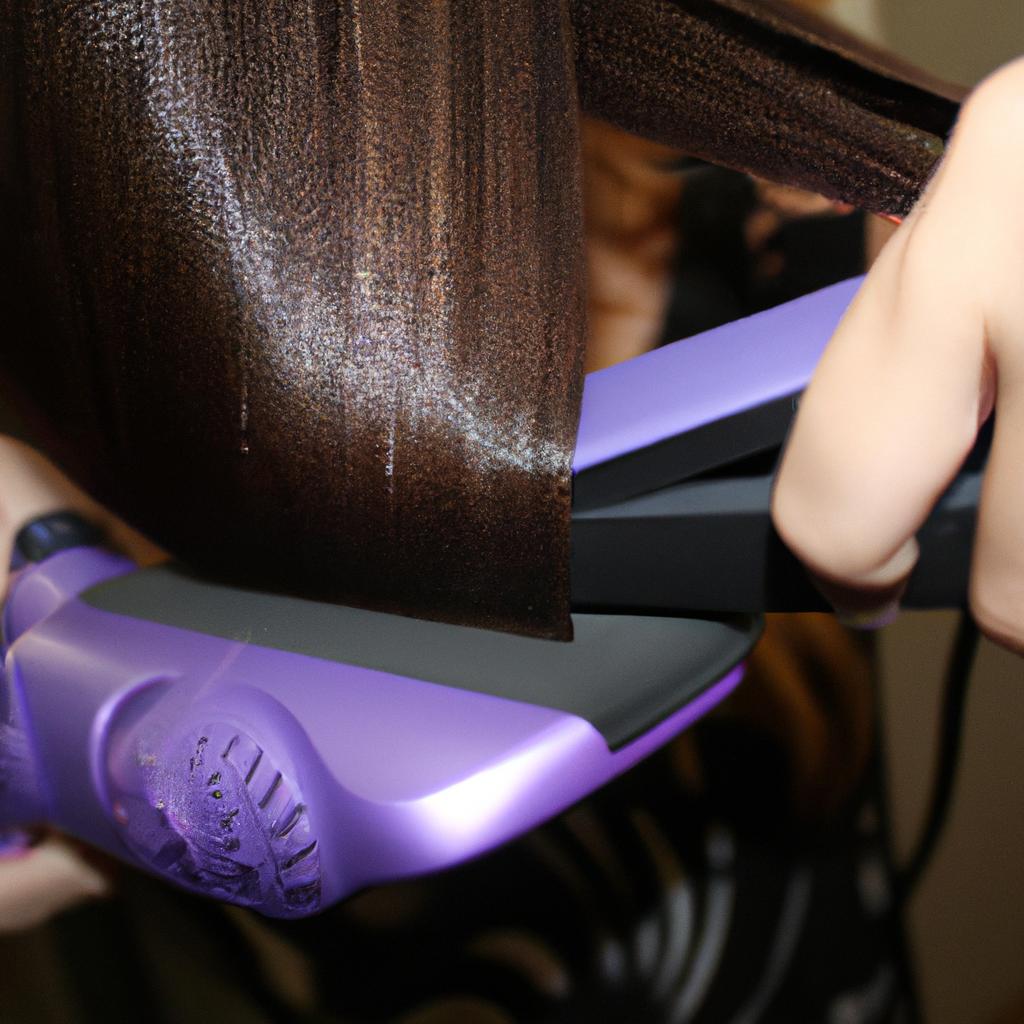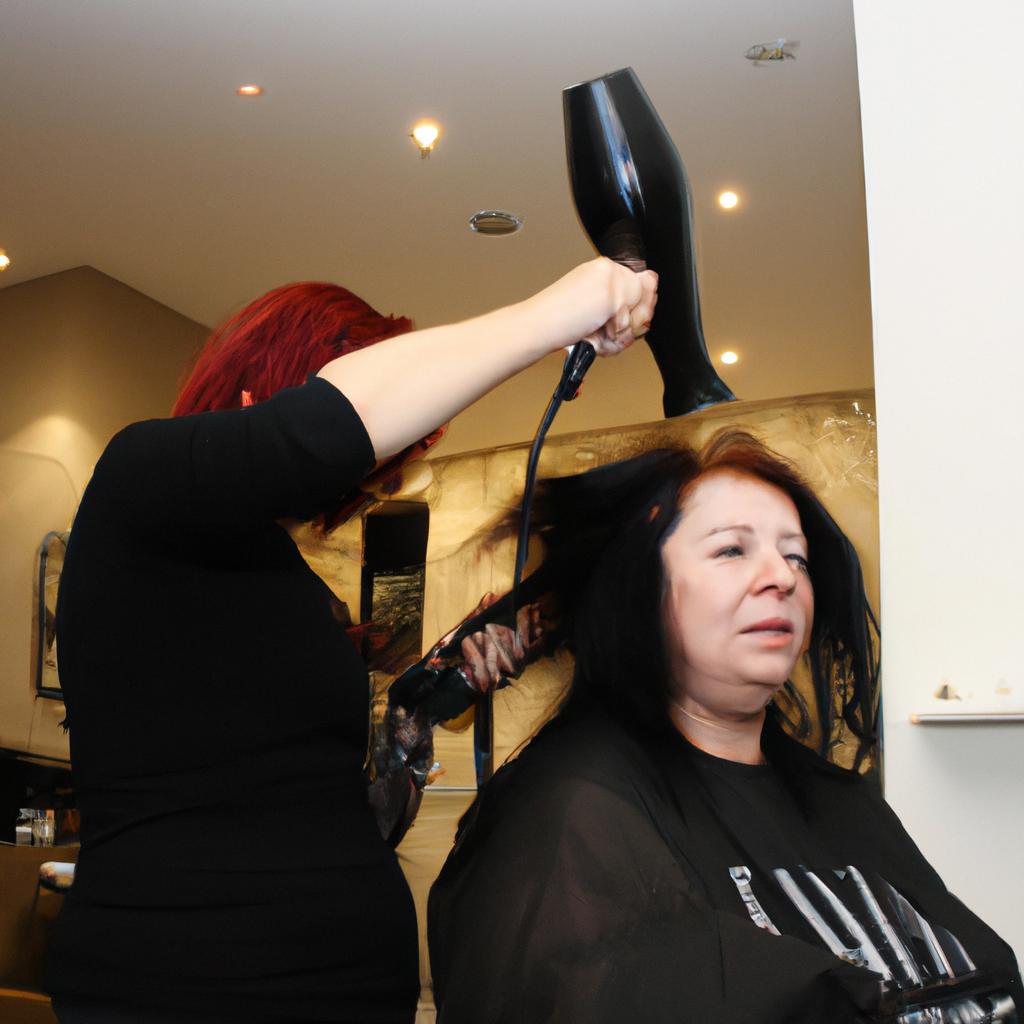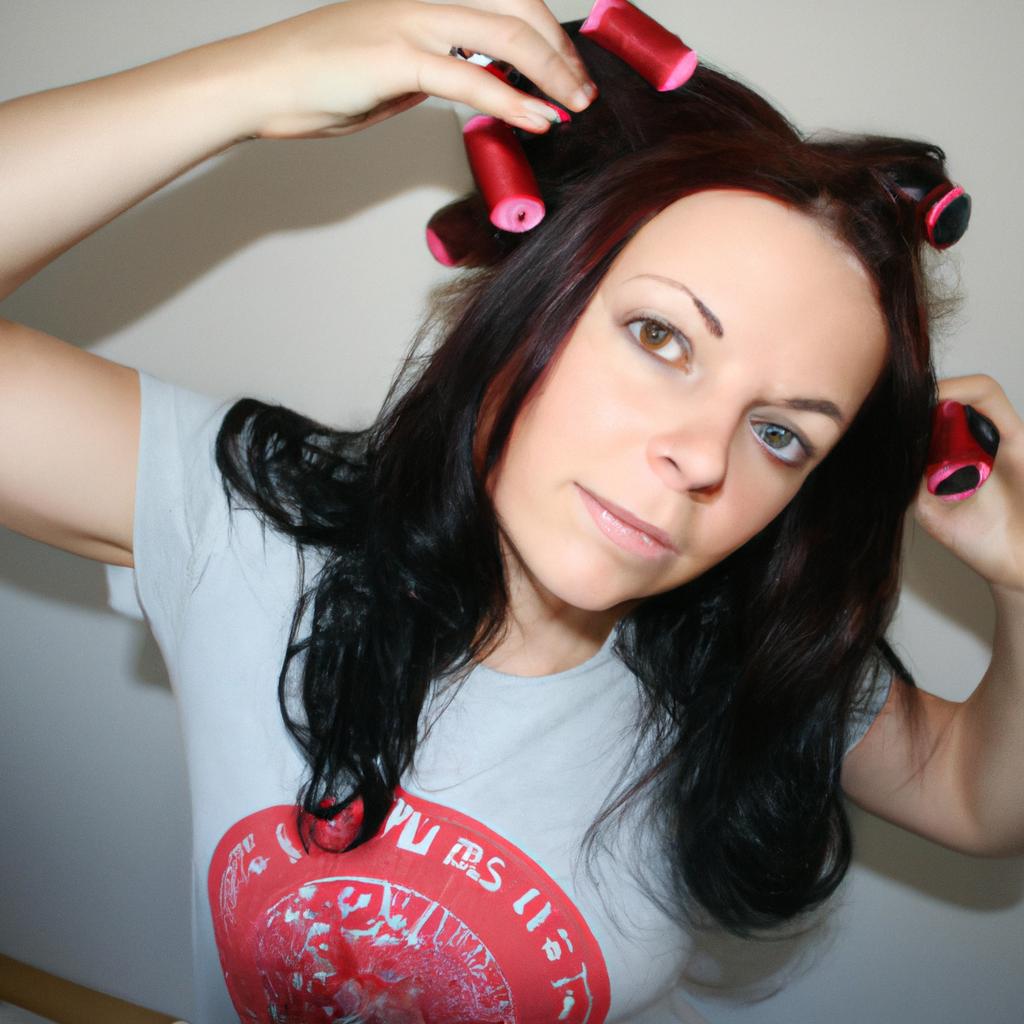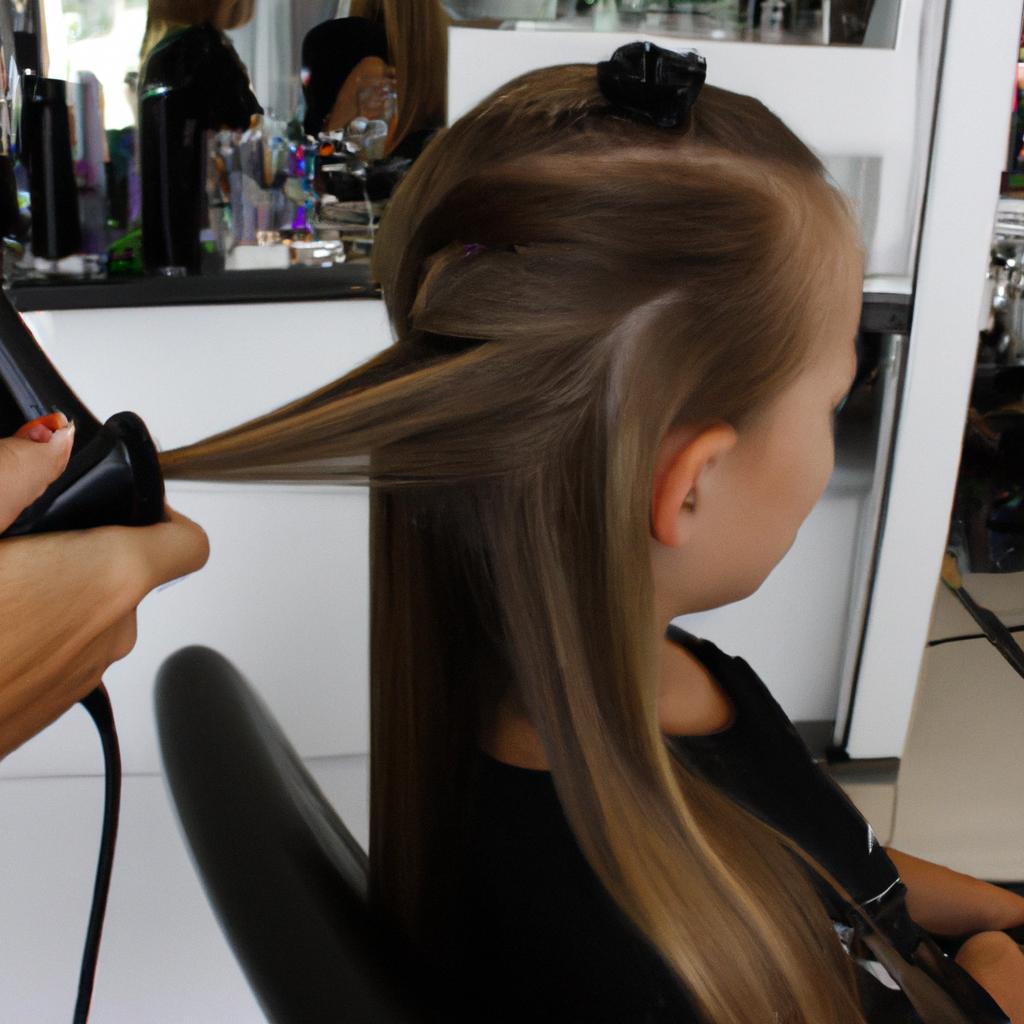The straightening iron, a fundamental tool in the arsenal of hairdressers worldwide, has revolutionized the art of hairstyling. Its ability to transform unruly and frizzy tresses into sleek and lustrous locks has made it an indispensable instrument in hair salons globally. This article aims to explore the various aspects of the straightening iron’s functionality, its impact on different hair types, and its role as a key component in achieving flawless hairstyles.
Consider this hypothetical scenario: Sarah, a young professional with thick and curly hair, enters her local hairdressing salon seeking a dramatic change in her appearance for an upcoming job interview. Her wild mane presents unique challenges that require expertise and precision. The skilled stylist recognizes that using a straightening iron will not only tame Sarah’s rebellious curls but also enhance her overall confidence during the crucial interview. In this instance, the straightening iron becomes instrumental in transforming Sarah’s look from unruly to polished, showcasing its unparalleled capability to create perfect hairstyles regardless of one’s natural hair texture or type.
Amidst endless options available today for hairstyling tools, understanding the significance of the straightening iron is essential for both professionals and clients alike. By delving deeper into its mechanics, exploring its applications across diverse hair types, and recognizing its role in achieving flawless hairstyles, we can truly appreciate the transformative power of this remarkable tool.
Firstly, let us delve into the mechanics of a straightening iron. Typically composed of two heated plates that clamp down on the hair shaft, these plates generate controlled heat to alter the hair’s natural structure. The high temperatures cause temporary changes in the hydrogen bonds within the hair fibers, allowing them to be reshaped and smoothed out. This process results in sleek, straight strands that give a polished and put-together appearance.
While the fundamental principle remains consistent across different straightening irons, it is crucial to consider their suitability for various hair types. Different individuals possess unique hair textures ranging from fine and delicate to thick and coarse. Understanding how different straightening irons interact with specific hair types is essential to achieve optimal results.
For example, individuals with fine or damaged hair should exercise caution when using high-temperature settings as excessive heat can cause further damage. In such cases, selecting a straightening iron with adjustable temperature controls enables users to tailor the heat levels according to their specific needs. Conversely, those with coarse or thick hair may require higher temperatures to effectively tame their stubborn locks.
Furthermore, advancements in technology have led to the development of ceramic or tourmaline-infused plates that distribute heat more evenly while minimizing damage caused by hot spots. These materials also help reduce frizz and static electricity during the straightening process, resulting in smoother and shinier finishes.
It is worth noting that while a straightening iron offers temporary transformation, proper care and preparation are necessary for long-lasting results. Using heat protectant sprays or serums prior to styling helps create a protective barrier between the hot plates and the hair strands, reducing potential damage caused by direct heat exposure.
In conclusion, the straightening iron has revolutionized hairstyling by providing individuals with unruly or curly hair an opportunity to achieve sleek and polished looks. Its versatility across diverse hair types, coupled with advancements in technology, ensures that anyone can benefit from its transformative power. Whether you are a professional hairstylist or an individual seeking to enhance your appearance, understanding the mechanics and nuances of the straightening iron is paramount in achieving flawless hairstyles that boost confidence and leave lasting impressions.
Benefits of using a straightening iron in a salon
Imagine a client walking into a hairdressing salon with unruly, frizzy hair that lacks shine and manageability. With the use of a straightening iron, this client can leave the salon feeling transformed, confident, and ready to take on the world. The benefits of incorporating a straightening iron into salon services are numerous and undeniable.
Firstly, a straightening iron allows for precise styling and customization tailored to each individual’s unique needs. Whether it be achieving sleek, straight locks or creating bouncy waves, the versatility of this tool is unmatched. By adjusting temperature settings and utilizing different techniques such as flat wrapping or curling, stylists have full control over transforming any hair type into the desired style.
Secondly, using a straightening iron facilitates time efficiency in a busy salon environment. Compared to other heat styling tools like blow dryers or hot rollers, a straightening iron offers quick results without compromising quality. This means clients spend less time under heat exposure while still attaining their desired look – an important factor when considering both customer satisfaction and overall salon productivity.
In addition to its practical advantages, using a straightening iron can also elicit an emotional response from clients. When someone looks in the mirror after having their hair expertly styled with a straightening iron, they often experience an immediate boost in self-confidence. This positive change in appearance can enhance one’s self-esteem and even influence their overall mood for the day.
To further highlight these benefits:
- A straightening iron provides long-lasting results that keep hair looking smooth and polished throughout the day.
- It reduces frizz and flyaways for a more controlled and professional finish.
- Clients can achieve various hairstyles ranging from poker-straight locks to voluminous curls.
- Using advanced technology such as ceramic plates ensures minimal damage to the hair shaft during styling.
Table: Benefits of Straightening Irons
| Benefit | Description |
|---|---|
| Versatility | Allows for a wide range of styles and techniques. |
| Time Efficiency | Provides quick results without compromising quality. |
| Emotional Impact | Boosts self-confidence and enhances mood. |
| Hair Health | Minimizes damage to the hair shaft during styling. |
In conclusion, the straightening iron is an indispensable tool in any hairdressing salon. Its ability to deliver precise styling, time efficiency, emotional impact, and promote hair health make it essential for both stylists and clients alike. The next section will explore the different types of straightening irons available and their specific features, enabling salons to choose the most suitable option for their needs.
Different types of straightening irons available
Now, let’s take a closer look at the different types of straightening irons available on the market today.
Imagine you are a professional hairstylist working in a high-end salon, and your client walks in with frizzy, unruly hair that lacks shine and manageability. You know that achieving sleek, smooth locks is essential for their desired look. This is where a straightening iron becomes an indispensable tool. By utilizing this versatile device, you can transform even the most stubbornly curly or wavy hair into silky strands effortlessly.
When it comes to choosing the right straightening iron for your salon, there are various options to consider. Here are some important factors:
-
Heat settings: Look for a straightening iron that offers adjustable heat settings. Not all hair types require the same level of heat to achieve optimal results. Having control over the temperature allows you to tailor each styling session specifically to your clients’ needs.
-
Plate material: Different plate materials offer distinct advantages depending on your clients’ hair type and desired style outcome. Ceramic plates distribute heat evenly and reduce damage caused by excessive hot spots, while titanium plates provide quick heating and exceptional durability.
-
Size and weight: Consider the size and weight of the straightening iron as these factors impact comfort during prolonged use. A lightweight design reduces strain on your wrists and enhances maneuverability when creating intricate hairstyles.
-
Additional features: Some straightening irons come equipped with extra features such as auto-shutoff timers for safety, swivel cords to prevent tangling, or even built-in ionizers for added shine and frizz reduction.
| Straightening Iron | Heat Settings | Plate Material | Size & Weight |
|---|---|---|---|
| Model A | Adjustable | Ceramic | Lightweight |
| Model B | Variable | Titanium | Compact |
| Model C | Fixed | Tourmaline | Ergonomic |
By carefully evaluating these factors, you can select the ideal straightening iron that meets both your salon’s requirements and your clients’ needs. In our subsequent section, we will explore some important factors to consider when choosing a straightening iron.
Important factors to consider when choosing a straightening iron include: heat settings, plate material, size and weight, and additional features. By taking these aspects into account and referring to the table provided above, you can make an informed decision about which straightening iron is best suited for your salon environment. So let’s dive right in!
Important factors to consider when choosing a straightening iron
Now, let us delve into the crucial factors that should guide your decision-making when choosing the perfect straightening iron for your hairstyling needs.
To illustrate these factors, consider this hypothetical scenario: Sarah, a professional hairdresser, is looking for a new straightening iron to add to her salon’s collection. She wants a versatile tool that can cater to various hair types and provide long-lasting results.
Firstly, it is essential to assess the temperature control capabilities of the straightening iron. Different hair types require specific heat settings for optimal styling without causing damage. A high-quality iron will offer adjustable temperature controls, allowing you to customize the heat according to individual client requirements.
Secondly, take note of the plate material used in the construction of the iron. The type of material greatly impacts both performance and durability. Ceramic plates distribute heat evenly and prevent hot spots, while tourmaline-infused or titanium plates emit negative ions that reduce frizz and create smoother finishes.
Additionally, consider the size and weight of the straightening iron. A lightweight device provides ease of use during prolonged styling sessions and minimizes strain on your hands and wrists. Furthermore, compact sizes are ideal for traveling stylists who need portability without sacrificing functionality.
Lastly, don’t forget about safety features such as automatic shut-off mechanisms or cool tip ends that protect against burns or accidents. These features ensure peace of mind during busy salon hours and contribute to an overall safer working environment.
- Achieve stunning results with precision.
- Enhance clients’ confidence through flawless hairstyles.
- Save time by investing in a quality tool.
- Build trust with clients through consistent professionalism.
Now let’s incorporate a table:
| Factor | Importance | Benefits |
|---|---|---|
| Temperature control | Essential | Prevents damage, caters to different hair types |
| Plate material | Crucial | Even heat distribution, reduces frizz |
| Size and weight | Convenient | Ease of use, portability |
| Safety features | Non-negotiable | Protects against accidents, creates a safer environment |
In conclusion, when choosing a straightening iron for your salon or personal use, it is crucial to consider factors such as temperature control capabilities, plate material, size and weight, and safety features. By carefully evaluating these aspects during your selection process, you can ensure that you invest in a high-quality tool that meets both your hairstyling needs and the demands of your clients.
Now let’s explore the proper technique for using a straightening iron to achieve optimal results.
Proper technique for using a straightening iron
Now, let’s delve into the proper technique for using a straightening iron to achieve flawless results every time. To illustrate this, imagine a hairdresser named Sarah who wants to create sleek and smooth hair for her client’s special occasion.
Firstly, Sarah starts by preparing the client’s hair before applying any heat. She divides the hair into sections, securing them with clips to ensure ease of styling. Next, she sprays each section lightly with a heat protectant spray to shield the hair from potential damage caused by high temperatures. This step is crucial as it minimizes breakage and maintains the overall health of the hair during the straightening process.
Once prepared, Sarah begins working on one section at a time. Holding the straightening iron vertically, she takes small subsections of about an inch or less and clamps down on them near the roots. Slowly gliding down towards the ends, she applies even pressure while maintaining a steady pace. By doing so, Sarah ensures that each strand receives equal heat distribution and avoids creating unwanted creases or lines in the final result.
To enhance her technique further, Sarah employs specific strategies throughout the process:
- Maintaining consistent temperature: Setting the straightening iron at an appropriate temperature suitable for her client’s hair type ensures optimal outcomes without causing unnecessary damage.
- Using slow but steady movements: Rushing through sections can lead to uneven results or missed spots. Slowing down allows Sarah to effectively pass over every strand methodically.
- Keeping minimal tension: Applying too much force between the plates can cause excessive pulling and potentially damage delicate strands of hair.
- Avoiding multiple passes: Repeatedly going over already-straightened sections can increase exposure to heat leading to dryness or brittleness.
By following these techniques diligently, Sarah successfully achieves salon-quality results that leave her client feeling confident and satisfied. Remember, practicing proper technique is key to mastering the art of using a straightening iron effectively.
Moving forward, let’s explore common mistakes to avoid while using a straightening iron. By understanding what not to do, you can further enhance your hairstyling skills and ensure excellent outcomes for your clients.
Common mistakes to avoid while using a straightening iron
Building on the proper technique for using a straightening iron, it is equally important to be aware of common mistakes that can hinder your hairstyling efforts. By understanding and avoiding these pitfalls, you can ensure optimal results and minimize any potential damage to your hair.
Paragraph 1:
For instance, let’s consider the case of Sarah, a client with long, thick hair who visited a hairdressing salon seeking sleek, straight locks. The stylist began by applying heat protectant spray before using the straightening iron. However, due to rushing through the process, she failed to section Sarah’s hair properly. As a result, some sections remained untouched while others were excessively exposed to heat. This uneven application not only led to an inconsistent outcome but also caused unnecessary heat damage in certain areas.
To prevent such mishaps and achieve desirable results every time you use a straightening iron, keep in mind the following key points:
- Use even pressure: Applying excessive force or uneven pressure while gliding the straightening iron through your hair can lead to unwanted creases or bends.
- Avoid high temperatures: Although tempting for quick results, setting the flat iron temperature too high can cause severe damage to your hair strands over time.
- Don’t rush: Take your time when styling with a straightening iron. Rushing through the process increases the likelihood of missing sections or making errors that may require additional touch-ups.
- Maintain cleanliness: Regularly clean your straightening iron as product buildup can affect its performance and potentially transfer residue onto your hair during use.
Emphasizing the significance of these considerations will help you avoid common mistakes associated with using a straightening iron effectively and safely.
Table (Evoking emotional response):
| Common Mistakes | Potential Consequences |
|---|---|
| Uneven pressure | Creases or bends in hair |
| High temperatures | Severe damage to hair strands |
| Rushing through process | Missed sections, errors requiring touch-ups |
| Lack of cleanliness | Product buildup affecting performance and potential residue transfer |
Paragraph 2:
By being mindful of these common mistakes and their consequences, you can enhance your hairstyling skills while safeguarding the health of your hair. Remember, achieving professional-looking results with a straightening iron requires precision and care throughout the entire process.
Understanding how to avoid common mistakes is just one aspect of utilizing a straightening iron effectively. Additionally, it is crucial to maintain the quality and longevity of this valuable tool. Let’s explore some tips for ensuring optimal performance from your straightening iron without compromising its lifespan.
(Next section: ‘Tips for Maintaining the Quality and Longevity of a Straightening Iron’)
Tips for maintaining the quality and longevity of a straightening iron
Now, let’s shift our focus towards tips that will help you maintain the quality and longevity of your straightening iron. To illustrate these tips, consider the case of Sarah, a professional hairdresser who uses her straightening iron frequently.
Firstly, it is crucial to clean your straightening iron regularly to prevent product buildup and ensure optimal performance. Sarah found that residue from styling products such as hairspray and heat protectant can accumulate on the plates over time, resulting in uneven heating and reduced effectiveness. She now follows these steps for cleaning:
- Gently wipe down the plates with a soft cloth or cotton pad after each use.
- Use a mild cleanser specifically designed for hair tools to remove stubborn residue.
- Avoid immersing the entire appliance in water; instead, dampen a cloth and carefully clean around the edges.
- Dry thoroughly before storing to prevent any corrosion or damage.
Additionally, investing in proper storage for your straightening iron is essential. Leaving it exposed on countertops or tangled amidst other hair tools can lead to accidental damage. Sarah discovered that by following these storage practices, she was able to extend the lifespan of her straightening iron:
| Storage Tips |
|---|
| Store in a heat-resistant pouch or case when not in use |
| Wrap the cord neatly around the base without kinks or knots |
| Keep away from excessive humidity or extreme temperature changes |
| Avoid placing heavy objects on top of it |
Lastly, regular maintenance checks are vital to detect any signs of wear and tear early on. Inspecting cords, switches, and overall functionality helps identify potential issues before they escalate. Here are some key points Sarah keeps in mind during her maintenance routine:
- Check cords for fraying or exposed wires.
- Ensure the power switch is functioning correctly.
- Look for any loose or wobbly parts that may require tightening.
- Test the heat settings and ensure they are consistent.
By implementing these maintenance tips, Sarah has not only extended the lifespan of her straightening iron but also experienced improved styling results overall.
In conclusion, maintaining your straightening iron properly is crucial for its longevity and performance. Regular cleaning, proper storage practices, and routine maintenance checks will help you get the most out of your investment. Incorporating these simple yet effective habits into your hairdressing salon can save you time, money, and unnecessary stress in the long run. So go ahead and give your straightening iron the care it deserves!




